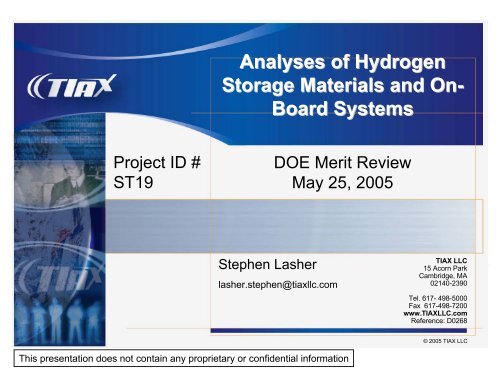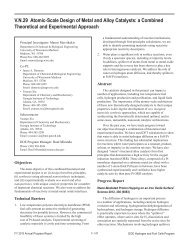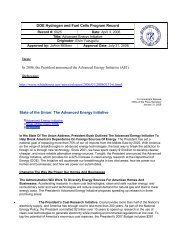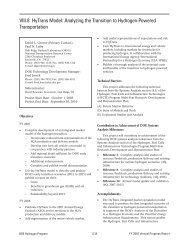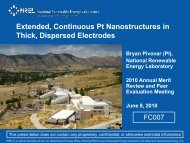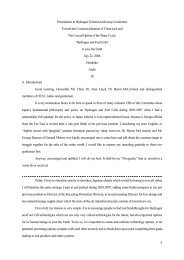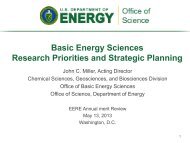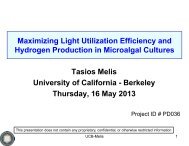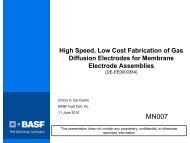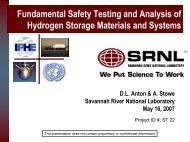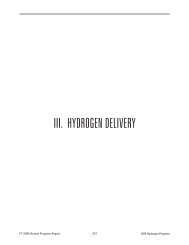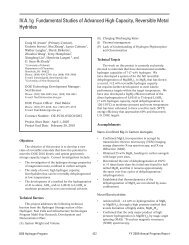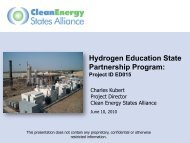Analyses of Hydrogen Storage Materials and On-Board Systems
Analyses of Hydrogen Storage Materials and On-Board Systems
Analyses of Hydrogen Storage Materials and On-Board Systems
Create successful ePaper yourself
Turn your PDF publications into a flip-book with our unique Google optimized e-Paper software.
<strong>Analyses</strong> <strong>of</strong> <strong>Hydrogen</strong><br />
<strong>Storage</strong> <strong>Materials</strong> <strong>and</strong> <strong>On</strong>-<br />
<strong>Board</strong> <strong>Systems</strong><br />
Project ID #<br />
ST19<br />
DOE Merit Review<br />
May 25, 2005<br />
Stephen Lasher<br />
lasher.stephen@tiaxllc.com<br />
TIAX LLC<br />
15 Acorn Park<br />
Cambridge, MA<br />
02140-2390<br />
Tel. 617- 498-5000<br />
Fax 617-498-7200<br />
www.TIAXLLC.com<br />
Reference: D0268<br />
© 2005 TIAX LLC<br />
This presentation does not contain any proprietary or confidential information
Overview<br />
Timeline<br />
Start date: June 2004<br />
End date: Sept 2009<br />
14% Complete<br />
Budget<br />
Total project funding<br />
‣DOE share = $1.5M<br />
‣No cost share<br />
FY04 = $112k<br />
FY05 = $200k<br />
Barriers addressed<br />
‣A. Cost<br />
‣C. Efficiency<br />
Barriers<br />
‣G. Life Cycle <strong>and</strong> Efficiency<br />
<strong>Analyses</strong><br />
Partners<br />
Team: GTI, Pr<strong>of</strong>. Robert<br />
Crabtree (Yale), Pr<strong>of</strong>. Daniel<br />
Resasco (U. <strong>of</strong> Oklahoma)<br />
Feedback: National Labs,<br />
Developers, Stakeholders<br />
SL/042905/D0268 ST19_Lasher_H2 <strong>Storage</strong>_final1.ppt<br />
1
Objectives<br />
Overall: Help guide DOE <strong>and</strong> developers toward promising<br />
R&D <strong>and</strong> commercialization pathways by evaluating the<br />
various on-board hydrogen storage technologies on a<br />
consistent basis<br />
Past Year: Develop system-level designs <strong>and</strong> estimate the<br />
cost, weight, <strong>and</strong> volume for a base case metal<br />
hydride/alanate hydrogen storage system<br />
‣ Selected sodium alanate as the base case<br />
‣ Developed results <strong>and</strong> compared to DOE targets <strong>and</strong><br />
results for compressed hydrogen storage<br />
SL/042905/D0268 ST19_Lasher_H2 <strong>Storage</strong>_final1.ppt<br />
2
Approach<br />
Overview<br />
Our on-board cost <strong>and</strong> performance estimates are based on detailed<br />
technology assessment <strong>and</strong> bottom-up cost modeling.<br />
Performance/<br />
Tech Assessment<br />
•Literature Search<br />
•Outline Assumptions<br />
•System Design <strong>and</strong><br />
Configurations<br />
•Process Models<br />
Cost Modeling<br />
•Document BOM<br />
•Determine Material<br />
Costs<br />
•Identify Processes <strong>and</strong><br />
Mnf. Equipment<br />
•Sensitivity <strong>Analyses</strong><br />
Overall Model<br />
Refinement<br />
•Developer <strong>and</strong><br />
Industry Feedback<br />
•Revise Assumptions<br />
<strong>and</strong> Model Inputs<br />
Interconnect<br />
Forming<br />
<strong>of</strong><br />
Interconnect<br />
Shear<br />
Interconnect<br />
Paint Braze<br />
onto<br />
Interconnect<br />
Braze<br />
$14<br />
$12<br />
Assembly &<br />
Inspection<br />
BOP<br />
Anode<br />
Anode<br />
Powder Prep<br />
Tape Cast<br />
Slip Cast<br />
Electrolyte<br />
Electrolyte<br />
Small Powder<br />
Prep<br />
Vacuum<br />
Plasma<br />
Spray<br />
Screen<br />
Print<br />
Fabrication<br />
Blanking /<br />
Slicing<br />
Sinter in Air<br />
1400C<br />
QC Leak<br />
Check<br />
Cathode<br />
Cathode<br />
Small Powder<br />
Prep<br />
Screen<br />
Print<br />
Vacuum<br />
Plasma<br />
Spray<br />
Sinter in Air<br />
Finish Edges<br />
System Cost, $/kWh<br />
$10<br />
$8<br />
$6<br />
$4<br />
Dehydriding Subsystem<br />
Tank<br />
Media<br />
Slurry Spray<br />
Slurry<br />
Spray<br />
Stack Assembly<br />
$2<br />
Note: Alternative production processes appear in gray to the<br />
bottom <strong>of</strong> actual production processes assumed<br />
$0<br />
TIAX Base Case 5,000 psi 10,000 psi<br />
BOM = Bill <strong>of</strong> <strong>Materials</strong><br />
SL/042905/D0268 ST19_Lasher_H2 <strong>Storage</strong>_final1.ppt<br />
3
Progress<br />
Design Assumptions<br />
We made design assumptions for the NaAlH 4 system based on literature<br />
review, developer feedback <strong>and</strong> TIAX experience.<br />
Design Parameter<br />
Value<br />
Basis<br />
H 2<br />
<strong>Storage</strong> Capacity<br />
5.6 kg<br />
ANL drive-cycle modeling<br />
NaAlH 4<br />
H 2<br />
Capacity<br />
4 wt%<br />
UTRC (Anton, Merit Review, May 04)<br />
Media<br />
Catalyst<br />
TiCl 3<br />
Bogdanovic & Schwickardi, JAC 97<br />
Catalyst Concentration<br />
4 mol%<br />
Bogdanovic & S<strong>and</strong>rock, MRS 02<br />
Thermal<br />
Powder Packing Density<br />
Heat <strong>of</strong> Decomposition<br />
0.6<br />
41 kJ/mol H 2<br />
UTRC (Anton, Merit Review, May 04)<br />
Reaction thermodynamics<br />
Min. Temperature 100 o C SNL (Wang, Merit Review, May 04)<br />
Max. Temperature<br />
Media Conductivity<br />
186 o C<br />
< 1 W/m K<br />
SNL (Gross, JAC 02)<br />
SNL (Wang, Merit Review, May 04)<br />
Media (hydrided) Specific Heat 1,418 J/kg K SNL (Dedrick, JAC 04 - draft)<br />
Al Foam Conductivity ~52 W/m K Metal Foams ~ k eff<br />
=0.28k Al@473K<br />
Al Specific Heat<br />
Max. Pressure<br />
~912 J/kg K<br />
100 bar (1470 psi)<br />
Aluminum alloy 2024 @473K<br />
UTRC (Anton, Merit Review, May 04)<br />
Mechanical<br />
Pressure Safety Factor 2.25 Industry st<strong>and</strong>ard<br />
Liner Thickness<br />
2 mm (14 ga)<br />
Estimate required for integrity<br />
SL/042905/D0268 ST19_Lasher_H2 <strong>Storage</strong>_final1.ppt<br />
4
Progress<br />
Material H 2<br />
Capacity Assumption<br />
We assume NaAlH 4 decomposes in a reversible two step reaction to<br />
achieve 4 wt% H 2 under practical conditions.<br />
Theoretical = 5.6 wt%<br />
“Demonstrated” ~ 4 wt%<br />
(absorption/desorption)<br />
‣ P ~ 100 / 2 bar<br />
‣ T ~ 100 / 120 ˚C<br />
TiCl 3 + NaAlH 4 = 3.2 wt%<br />
‣ 4 mol% Ti-precursor added<br />
to catalyze reaction<br />
‣ Ti + NaAlH 4 = 3.8 wt%<br />
High pressure output (e.g. 8<br />
atm) would limit to 1st Step<br />
8 bar<br />
Reference: Gross, K. (SNL) presentation at DOE <strong>Hydrogen</strong> <strong>and</strong> Fuel Cells Annual<br />
Merit Review, May 2003<br />
1 st Step: NaAlH 4<br />
1/3 Na 3<br />
AlH 6<br />
+ 2/3 Al + H 2<br />
(g) H 2<br />
wt%=3.7<br />
2 nd Step: Na 3<br />
AlH 6<br />
3 NaH + Al + 3/2 H 2<br />
(g) H 2<br />
wt%=1.9<br />
SL/042905/D0268 ST19_Lasher_H2 <strong>Storage</strong>_final1.ppt<br />
5
Progress<br />
Tank Conceptual Design<br />
We developed a conceptual design for a tank to accommodate rapid<br />
heat exchange <strong>and</strong> high adsorption pressure conditions (100 bar).<br />
TIAX Base Case Design (5.6 kg H 2<br />
): Carbon Fiber Composite Tank<br />
1.5m<br />
HTF<br />
HTF Manifold<br />
Insulation<br />
4% Al foam<br />
GF<br />
3” diameter size<br />
CF<br />
Liner<br />
Sintered SS Filters<br />
Legend<br />
0.5m<br />
H 2<br />
Metal Foam<br />
Al = Aluminum<br />
GF = Glass Fiber<br />
CF = Carbon Fiber<br />
HTF = Heat Transfer Fluid<br />
HX = Heat Exchanger<br />
SS = Stainless Steel<br />
SL/042905/D0268 ST19_Lasher_H2 <strong>Storage</strong>_final1.ppt<br />
6
Progress<br />
Tank Manufacturing<br />
We assumed a tank manufacturing process that loads the alanate in<br />
several automated steps under an inert atmosphere.<br />
Shape Al<br />
Foam<br />
Fill in NaAlH4<br />
<strong>and</strong> Binder<br />
into Al Foam<br />
Sintering Pack<br />
Into Solid<br />
Status<br />
Machining<br />
End Plates<br />
Extrusion<br />
Cylinder<br />
Spin Seal<br />
Ends To<br />
Form Cylinder<br />
Brazing<br />
Optional Process:<br />
Shape Al<br />
Foam<br />
Form<br />
Al /SS 316<br />
Can<br />
Assembly Al<br />
Form into Can<br />
Fill in Hydrides<br />
Size SS 316<br />
Tubes<br />
Tubes <strong>and</strong><br />
<strong>On</strong>e End Plate<br />
Stamp<br />
Semi-Sphere<br />
Cap<br />
Machining<br />
Two Bosses<br />
*Super Binder needs to be discovered.<br />
Insert Al Foam<br />
Packs <strong>and</strong><br />
Separators<br />
Laser Brazing<br />
HE End Plate<br />
Bend<br />
Tubes<br />
Fabricate Fluid<br />
End plates<br />
Brazing<br />
Fluid<br />
End Plates<br />
With Two<br />
Tubes<br />
Laser<br />
Brazing<br />
End<br />
Plates<br />
With Fluid<br />
Plates<br />
Insert Hydride<br />
And Heat<br />
Exchanger<br />
Into Liner<br />
Laser<br />
Brazing<br />
Liner<br />
End Cap<br />
Heat Exchange<br />
Fluid In-Out Side<br />
Alternative processes, such as loading the alanate in molten form after<br />
CF curing, may be necessary for high volume manufacture.<br />
SL/042905/D0268 ST19_Lasher_H2 <strong>Storage</strong>_final1.ppt<br />
7
Progress<br />
System Conceptual Design<br />
The complete system requires significant balance <strong>of</strong> plant (BOP)<br />
components for overall thermal management <strong>and</strong> flow control.<br />
Fill Station<br />
Interface<br />
Refueling<br />
Interface<br />
<strong>Hydrogen</strong><br />
H 2<br />
100 bar<br />
HTF<br />
~100˚C<br />
HTF<br />
~125˚C<br />
Check Valve<br />
in Fill Port<br />
HTF** In<br />
HTF Out<br />
Pressure<br />
Relief<br />
Valve<br />
<strong>Storage</strong> Tank<br />
Sodium Alanate Pressure<br />
Vessel w/ In-tank Heat<br />
Exchanger<br />
Temperature<br />
Transducer<br />
Pressure<br />
Transducer<br />
Thermal<br />
Relief<br />
Device<br />
Pressure<br />
Relief<br />
Valve<br />
Temperature<br />
Transducer<br />
Check<br />
Valve<br />
Dehydriding System<br />
Combustion Air<br />
Blower<br />
Heat Exchanger w/<br />
Low NO x H 2 Combustor<br />
Motor<br />
M<br />
Pump<br />
Ball Valve<br />
Solenoid Valve<br />
(Normally Closed)<br />
Primary<br />
Pressure Regulator<br />
<strong>Hydrogen</strong> Line<br />
Heat Transfer Line<br />
Data & Comm. Line<br />
In-Tank Regulator<br />
Fill<br />
System<br />
Control<br />
Module<br />
Data & Comm. Line<br />
to Fuel Control<br />
Solenoid Valve<br />
(Normally Closed)<br />
Check Valve<br />
<strong>Hydrogen</strong> Line<br />
to Fuel Cell<br />
*Note: Schematic is representative only.<br />
SL/042905/D0268 ST19_Lasher_H2 <strong>Storage</strong>_final1.ppt<br />
8
Progress<br />
Dehydriding Subsystem<br />
We sized a compact, fin <strong>and</strong> tube design for the heat transfer fluid (HTF)<br />
heat exchanger.<br />
Thermal integration with the stack was not considered at this time.<br />
SL/042905/D0268 ST19_Lasher_H2 <strong>Storage</strong>_final1.ppt<br />
9
Progress<br />
Other Design Issues<br />
We have identified a number <strong>of</strong> system-level issues that must be<br />
addressed by the on-going R&D.<br />
Issues<br />
Start-up<br />
Material<br />
Life<br />
Safety<br />
Thermal<br />
Integration<br />
Refueling<br />
Comments<br />
•33 MJ (5% <strong>of</strong> 5.6 kg H 2 ) required to heat media from 0˚C<br />
•Is secondary H 2 storage (or battery/electric heater) needed<br />
for start-up?<br />
•Limited cycling data<br />
•Powder <strong>and</strong> catalyst can segregate <strong>and</strong> lose effectiveness<br />
•Powder is highly explosive, reacts with water or air<br />
•Is an inert atmosphere needed for vehicle refueling <strong>and</strong><br />
tank manufacturing?<br />
•24% H 2 required for dehydriding heat<br />
•Is waste heat from power unit sufficient <strong>and</strong> coincident?<br />
•Two-fluid dispensing (H 2 gas <strong>and</strong> HTF) is required<br />
•Long refueling times (minutes or hours?)<br />
SL/042905/D0268 ST19_Lasher_H2 <strong>Storage</strong>_final1.ppt<br />
10
Results<br />
Weight Comparison<br />
Sodium alanate will not meet the DOE weight target. <strong>Materials</strong> with<br />
greater than 7 wt% may be required to meet even the ’05 target.<br />
400<br />
350<br />
Sodium<br />
Alanate<br />
Wt% = 1.7%<br />
Compressed <strong>Hydrogen</strong><br />
<strong>Storage</strong><br />
BOP<br />
Dehydriding Subsystem<br />
Balance <strong>of</strong> Tank<br />
System Weight, kg<br />
300<br />
250<br />
200<br />
150<br />
100<br />
6.7% 6.3%<br />
Packed Media / H2<br />
Stored<br />
Carbon Fiber<br />
2007 Target<br />
= 4.5 wt%<br />
50<br />
0<br />
TIAX Base Case 5,000 psi 10,000 psi<br />
Note:<br />
5,000 <strong>and</strong> 10,000 psia Cases<br />
based on: Carlson, E., et al.<br />
(TIAX), “Cost <strong>Analyses</strong> <strong>of</strong> Fuel<br />
Cell Stacks/<strong>Systems</strong>”, Merit<br />
Review, Philadelphia, PA, May<br />
24-27, 2004.<br />
SL/042905/D0268 ST19_Lasher_H2 <strong>Storage</strong>_final1.ppt<br />
11
Results<br />
Volume Comparison<br />
The sodium alanate system will likely be about 40% larger than the<br />
10,000 psi compressed hydrogen storage system.<br />
350<br />
300<br />
Sodium<br />
Alanate<br />
Compressed <strong>Hydrogen</strong><br />
<strong>Storage</strong><br />
BOP<br />
Dehydriding Subsystem<br />
Balance <strong>of</strong> Tank<br />
System Volume, L<br />
250<br />
200<br />
150<br />
100<br />
Packed Media / H2<br />
Stored<br />
Carbon Fiber<br />
2007 Target<br />
= 1.2 kWh/L<br />
50<br />
0<br />
TIAX Base Case 5,000 psi 10,000 psi<br />
Note:<br />
5,000 <strong>and</strong> 10,000 psia Cases<br />
based on: Carlson, E., et al.<br />
(TIAX), “Cost <strong>Analyses</strong> <strong>of</strong> Fuel<br />
Cell Stacks/<strong>Systems</strong>”, Merit<br />
Review, Philadelphia, PA, May<br />
24-27, 2004.<br />
Note: Volume results do not include void spaces between components (i.e., 100% packing factor was applied).<br />
SL/042905/D0268 ST19_Lasher_H2 <strong>Storage</strong>_final1.ppt<br />
12
Results<br />
Factory Cost Comparison<br />
Our assessment indicates the manufactured cost <strong>of</strong> a sodium alanate<br />
system will be on-par with 10,000 psi compressed gas.<br />
System Cost, $/kWh<br />
14<br />
12<br />
10<br />
8<br />
6<br />
4<br />
Sodium Alanate<br />
Compressed <strong>Hydrogen</strong><br />
<strong>Storage</strong><br />
Assembly &<br />
Inspection<br />
BOP<br />
Dehydriding Subsystem<br />
Balance <strong>of</strong> Tank<br />
Packed Media / H2<br />
Stored<br />
Carbon Fiber<br />
2007 Target<br />
= $6 /kWh<br />
2<br />
0<br />
TIAX Base Case 5,000 psi 10,000 psi<br />
Note:<br />
5,000 <strong>and</strong> 10,000 psia Cases<br />
based on: Carlson, E., et al.<br />
(TIAX), “Cost <strong>Analyses</strong> <strong>of</strong> Fuel<br />
Cell Stacks/<strong>Systems</strong>”, Merit<br />
Review, Philadelphia, PA, May<br />
24-27, 2004.<br />
SL/042905/D0268 ST19_Lasher_H2 <strong>Storage</strong>_final1.ppt<br />
13
Results<br />
Example <strong>of</strong> Sensitivity Analysis<br />
Assuming a very optimistic media cost <strong>of</strong> $3/kg reduces the overall cost<br />
<strong>of</strong> the system by less than 15%.<br />
Sensitivity Analysis - Factory Cost ($/kWh)<br />
10 12 14 16 18<br />
Media Cost<br />
NaAlH4 H2 Capacity<br />
Powder Packing Density<br />
Base<br />
Case =<br />
$13/kWh<br />
Factors<br />
Catalyzed Media Cost ($/kg)<br />
NaAlH 4 H 2 Capacity<br />
Powder Packing Density<br />
Baseline<br />
5.2<br />
4%<br />
0.6<br />
TIAX Base Case<br />
Min<br />
3<br />
3.7%<br />
0.6<br />
Max<br />
10<br />
5.6%<br />
0.9<br />
SL/042905/D0268 ST19_Lasher_H2 <strong>Storage</strong>_final1.ppt<br />
14
Conclusions<br />
Media hydrogen capacity<br />
‣Some alanates could have<br />
higher reversible wt%<br />
‣But more challenging<br />
thermal requirements<br />
‣May need >13 wt% to<br />
achieve 9 wt% target<br />
Other material issues<br />
‣Kinetics are slow—refueling<br />
<strong>and</strong> transient response<br />
‣Life is unknown—cycling<br />
<strong>and</strong> poisoning<br />
Tank <strong>and</strong> BOP<br />
‣~60% <strong>of</strong> system cost <strong>and</strong><br />
~50% <strong>of</strong> system weight<br />
‣Containment <strong>and</strong><br />
contamination<br />
System integration<br />
‣Thermal integration with<br />
power unit is critical<br />
‣1.24X larger if H 2 needed<br />
for dehydriding reaction is<br />
included<br />
SL/042905/D0268 ST19_Lasher_H2 <strong>Storage</strong>_final1.ppt<br />
15
Future Work Categories <strong>of</strong> <strong>Storage</strong><br />
We are in the process <strong>of</strong> evaluating the base case for chemical hydrides<br />
<strong>and</strong> will begin the assessment <strong>of</strong> high surface area sorbents in 2006.<br />
<strong>Storage</strong><br />
Technology<br />
Status<br />
Base<br />
Case<br />
Tech<br />
Status<br />
<strong>Storage</strong><br />
State<br />
H 2<br />
Release<br />
Refuel-<br />
ing<br />
Compressed <strong>and</strong><br />
Liquid <strong>Hydrogen</strong><br />
Done<br />
2003 *<br />
5,000<br />
psi<br />
Mature<br />
Gas<br />
Pressure<br />
regulator<br />
H 2<br />
gas<br />
Reversible <strong>On</strong>board:<br />
Alanates<br />
Done<br />
2005<br />
Sodium<br />
Alanate<br />
Early<br />
prototype<br />
Solid<br />
Endothermic<br />
desorption<br />
H 2<br />
gas<br />
<strong>and</strong> HTF<br />
loop<br />
Regenerable Offboard:<br />
Chemical<br />
WIP<br />
2005<br />
Sodium<br />
Borohydride<br />
Prototype<br />
Aqueous<br />
solution<br />
Exothermic<br />
hydrolysis<br />
Aqueous<br />
solution<br />
in/out<br />
High Surface<br />
Area Sorbents:<br />
Carbon<br />
2006<br />
TBD<br />
R&D<br />
Solid<br />
(low T?)<br />
Endothermic<br />
desorption<br />
H 2<br />
gas<br />
(low T?)<br />
1 HTF = Heat Transfer Fluid<br />
* Compressed hydrogen was evaluated under a separate DOE contract.<br />
SL/042905/D0268 ST19_Lasher_H2 <strong>Storage</strong>_final1.ppt<br />
16
Future Work Well-to-Wheels Analysis<br />
In future work, we will evaluate overall WTW performance <strong>and</strong> lifecycle<br />
cost for all the hydrogen storage options.<br />
SL/042905/D0268 ST19_Lasher_H2 <strong>Storage</strong>_final1.ppt<br />
17
Publications <strong>and</strong> Presentations<br />
Presentations under the title: “<strong>Analyses</strong> <strong>of</strong> <strong>Hydrogen</strong> <strong>Storage</strong> <strong>Materials</strong><br />
<strong>and</strong> <strong>On</strong>-<strong>Board</strong> <strong>Systems</strong>”; Lasher et al<br />
‣ <strong>Hydrogen</strong> <strong>Storage</strong> Tech Team Meeting; April 21, 2005; Detroit MI<br />
‣ <strong>Storage</strong> System Analysis Meeting; March 29, 2005; Washington DC<br />
‣ <strong>Hydrogen</strong> <strong>Storage</strong> Tech Team Meeting; August 19, 2004; Detroit MI<br />
Presentations under the title: “Comparison <strong>of</strong> <strong>Hydrogen</strong> <strong>Storage</strong><br />
Options”; Lasher et al<br />
‣ NHA Annual <strong>Hydrogen</strong> Conference; March 30, 2005; Washington DC<br />
SL/042905/D0268 ST19_Lasher_H2 <strong>Storage</strong>_final1.ppt<br />
18
<strong>Hydrogen</strong> Safety<br />
The most significant hydrogen hazard associated with this project is:<br />
‣ None<br />
‣ This is an analysis project with no on-going or proposed h<strong>and</strong>s-on<br />
laboratory or hardware development work<br />
Our approach to deal with this hazard is:<br />
‣ None required<br />
SL/042905/D0268 ST19_Lasher_H2 <strong>Storage</strong>_final1.ppt<br />
19


